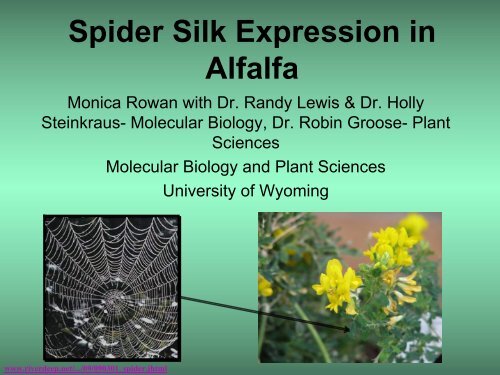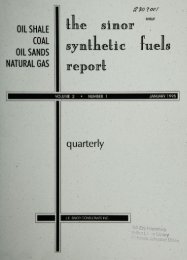Spider Silk Expression in Alfalfa
Spider Silk Expression in Alfalfa
Spider Silk Expression in Alfalfa
You also want an ePaper? Increase the reach of your titles
YUMPU automatically turns print PDFs into web optimized ePapers that Google loves.
<strong>Spider</strong> <strong>Silk</strong> <strong>Expression</strong> <strong>in</strong><br />
<strong>Alfalfa</strong><br />
Monica Rowan with Dr. Randy Lewis & Dr. Holly<br />
Ste<strong>in</strong>kraus- Molecular Biology, Dr. Rob<strong>in</strong> Groose- Plant<br />
Sciences<br />
Molecular Biology and Plant Sciences<br />
University of Wyom<strong>in</strong>g<br />
www.riverdeep.net/.../09/090301_spider.jhtml
<strong>Silk</strong> <strong>in</strong> spiders
Why <strong>Spider</strong> <strong>Silk</strong>?<br />
Comparisons of Mechanical<br />
Properties of <strong>Spider</strong> <strong>Silk</strong><br />
Material Strength (Nm -2) Elasticity (%) Energy to Break (Jkg -1)<br />
Dragl<strong>in</strong>e <strong>Silk</strong> 4 x 10^9 35 4 x 10^5<br />
KEVLAR 4 x 10^9 5 3 x 10^4<br />
Rubber 1 x 10^6 600 8 x 10^4<br />
Tendon 1 x 10^9 5 5 x 10^3__________<br />
• Data derived from Gosl<strong>in</strong>e, J.M.; Dennv, M.W.; Demont, M.E. Nature 1984,<br />
309,551
What can silk be used for?<br />
‣ New textiles<br />
‣ Improved shield<strong>in</strong>g material that<br />
could take the place of Kevlar <strong>in</strong><br />
bulletproof vests.<br />
‣ Composite materials for build<strong>in</strong>g and<br />
aerospace applications<br />
‣ F<strong>in</strong>e sutures, artificial tendons and<br />
ligaments
Why Plant <strong>Expression</strong>?<br />
‣Low cost (10-50 fold<br />
less than <strong>in</strong> E. coli).<br />
‣Easy to scale up.<br />
‣Agricultural<br />
advances provide<br />
for rapid harvest<strong>in</strong>g<br />
and process<strong>in</strong>g.<br />
http://www.wapa.gov/es/pubs/esb/1999/99Oct/at_cl<strong>in</strong>ton.htm
Plant <strong>Expression</strong> of <strong>Silk</strong><br />
• Genetic Eng<strong>in</strong>eer<strong>in</strong>g of<br />
plants is well<br />
established<br />
• Adaptation as largescale<br />
bioreactors for<br />
commercially valuable<br />
molecules<br />
• Production of spider<br />
silk has been h<strong>in</strong>dered<br />
because of lack of a<br />
suitable large scale<br />
production system<br />
Tobacco<br />
Arabidopsis<br />
Potato<br />
<strong>Alfalfa</strong>
<strong>Alfalfa</strong> (Medicago sativa L.)<br />
‣ Perennial crop,<br />
adaptable<br />
‣ Open to transformation<br />
‣ High prote<strong>in</strong> content<br />
- Up to 24% of dry weight<br />
is prote<strong>in</strong><br />
- If expressed at 1-2% of<br />
TSP, yield of 218 kg of<br />
silk prote<strong>in</strong>/acre/year<br />
- 2.5–12g/kg leaf tissue<br />
‣ High MW prote<strong>in</strong>s<br />
http://www.ars.usda.gov/images/docs/3172_3356/<strong>Alfalfa</strong>%20Flower.jpg
Comparison of various expression systems<br />
for the production of recomb<strong>in</strong>ant silk prote<strong>in</strong><br />
under optimized conditions.<br />
<strong>Expression</strong><br />
System<br />
Prote<strong>in</strong><br />
Concentration<br />
Total Prote<strong>in</strong><br />
Yield<br />
Production<br />
Time<br />
Bacteria 100mg/L; 30,000L<br />
fermentor<br />
3kg/run<br />
2-4 months<br />
Goats<br />
15g/L; 8L/day; with<br />
a lactation of 150 d<br />
18kg/goat/year<br />
1-2 years<br />
<strong>Alfalfa</strong><br />
1% of total soluble<br />
prote<strong>in</strong>, 10T/acre<br />
assum<strong>in</strong>g 5<br />
cutt<strong>in</strong>gs/year<br />
218kg/acre/year<br />
4-5 years
Project Objectives<br />
1) Insert a synthetic gene for<br />
spider silk <strong>in</strong>to the alfalfa<br />
genome.<br />
2) Analyze resultant plants to<br />
determ<strong>in</strong>e gene copy number<br />
and prote<strong>in</strong> expression level.<br />
3) Design an effective protocol<br />
to purify spider silk prote<strong>in</strong>s<br />
from alfalfa.<br />
4) Cross plants express<strong>in</strong>g silk<br />
with a Wyom<strong>in</strong>g adapted<br />
cultivar.
Orig<strong>in</strong>al silk constructs<br />
‣Synthetic constructs based on N. clavipes sequence.<br />
‣E. coli codon bias<br />
‣MaSp 1 -> 16 repeats of 99 bp, each encod<strong>in</strong>g:<br />
GGAGQGGYGGLGSQGAGRGGLGGQGAGAAAAAA<br />
GGX = 3 10 helix = elasticity (GA)n/(A)n = beta sheet = strength
Transformation of alfalfa<br />
Selective + hormones: formation of calli<br />
‣ A. tumefaciens: LBA4404<br />
‣ <strong>Alfalfa</strong>: Regen S27<br />
‣Transformed ~120 leaves/clone<br />
‣Explants moved to soil: 30/clone<br />
•kan<br />
•ticar<br />
•k<strong>in</strong>et<strong>in</strong><br />
•2,4-D<br />
Selective – hormones: encourages root and shoot development
Parent Generation<br />
‣MaSp1 + C #7 X WisFal<br />
‣Analysis of F1 progeny<br />
– Southern (DNA level)<br />
– Western (Prote<strong>in</strong> level)
F1 Southern Blot analysis<br />
‣Digested alfalfa genomic DNA with the restriction enzyme NdeI.<br />
‣Hybridized with a radioactively-labeled homologous probe.<br />
‣ Exam<strong>in</strong>ed images for the presence of a 2.3kb-hybridiz<strong>in</strong>g fragment,<br />
which <strong>in</strong>dicated the silk gene was <strong>in</strong>corporated <strong>in</strong>to the plant genome.
Extraction of TSP’s from<br />
MaSp1+C-transformed alfalfa<br />
‣ Ground leaves <strong>in</strong> liquid<br />
N 2<br />
‣ Prepared crude extract<br />
‣ Heat-treated soluble<br />
extract; 90 o C, 10’<br />
‣ Pelleted precipitated<br />
prote<strong>in</strong>s<br />
‣ Exam<strong>in</strong>ed by SDS-<br />
PAGE
Western Blot Analyses<br />
MW<br />
G1<br />
G3<br />
B3<br />
O1<br />
WT<br />
M4 (+)<br />
75<br />
50<br />
61kD <strong>Spider</strong> <strong>Silk</strong><br />
Prote<strong>in</strong> Band<br />
AB α M 4 (MaSp1)
Summary of Southern/Western<br />
results<br />
‣105 F1 plants analyzed<br />
- 74 positive on DNA level<br />
- 4 positive on the prote<strong>in</strong> expression<br />
level<br />
‣Consequently only 4% of the F1 plants<br />
tested are express<strong>in</strong>g the silk prote<strong>in</strong>.
WHY such low numbers?<br />
‣Gene Silenc<strong>in</strong>g<br />
– Multiple transgene copies<br />
– Methylation of promoter region<br />
‣Prote<strong>in</strong> <strong>in</strong>stability….prote<strong>in</strong> itself<br />
– No subcellular target<strong>in</strong>g
Improvements<br />
‣ Change codon usage (<strong>in</strong>crease yield):<br />
- orig<strong>in</strong>al constructs -> E. coli codon bias<br />
- designed new constructs -> alfalfa codon bias<br />
‣ Change vector (ER retention signal):<br />
- orig<strong>in</strong>al constructs -> pIBT110<br />
- use new vector -> pCB301-KDEL
New b<strong>in</strong>ary vector<br />
‣ pCB301-kan-CaMv-leb4sig-100xELP-cmyc-KDEL<br />
100xELP<br />
100xELP<br />
(VPGXX) 100<br />
KDEL<br />
LB<br />
nptIII (kanR)<br />
cmyc tag<br />
legum<strong>in</strong><br />
signal peptide<br />
Met<br />
CaMv 35S<br />
promoter<br />
DraIII<br />
BamHI<br />
XbaI<br />
pCB301-kan 100 ELP<br />
8359 bp<br />
neo (kanR)<br />
RB
Future Work<br />
‣Collaboration with Medicago (Canada)<br />
- New vectors<br />
‣Transient Assay Development<br />
‣Transformed leaves with new constructs<br />
and analyze resultant plants.
Acknowledgements<br />
Randy Lewis, Ph.D.<br />
Holly Ste<strong>in</strong>kraus, Ph.D.<br />
Rob<strong>in</strong> Groose, Ph.D.<br />
Entire Lewis Lab<br />
NSF EPSCoR for the opportunity
Questions?















![pace SrntfletIc fne]its report - Alliance Digital Repository](https://img.yumpu.com/10493335/1/190x245/pace-srntfletic-fneits-report-alliance-digital-repository.jpg?quality=85)
